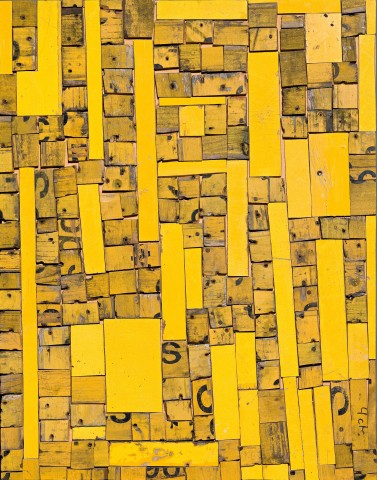GOLD RUSH, 1996
ROSALIE GASCOIGNE
sawn retroreflective plywood road signs and painted wood from soft drink boxes on board
77.0 x 60.0 cm
signed, dated and inscribed with title verso: Rosalie Gascoigne / 1996 / GOLD RUSH
Greenway Art Gallery, Adelaide
Private collection, Melbourne
Deutscher and Hackett, Sydney, 1 September 2010, lot 5
Private collection, Perth
Greenaway Art Gallery at Fifth Australian Contemporary Art Fair, Melbourne, 2 – 6 October 1996
MacDonald, V., Rosalie Gascoigne, Regaro, Sydney, 1998, p. 108
Gascoigne, M., Rosalie Gascoigne. A Catalogue Raisonné, ANU Press, Canberra, 2019, cat. 579, p. 289 (illus.)
Goldfield, 1996, Private collection, Switzerland, illus. in Gascoigne, M., op cit., cat. 578, p. 289
‘Gascoigne's use of modernist strategies, her simple but complex means of construction – those of fragmentation, re-assemblage, repetition, tessellation and compression – effect an ordering and accentuation which is also poetic in its workings … She experiences, selects and creates, using a relatively narrow range of materials in order to present the work to us resonating with a virtually endless allusive power. Her results are spectacular, exquisite distillations and extractions, grounded in her personalised experience of the land’.1
With her training in the formal discipline of Ikebana complementing her intuitive understanding of the nature of materials, her deep attachment to her environment and later interest in modern art, Rosalie Gascoigne remains one of Australia's most revered assemblage artists. Bespeaking a staunchness and scrupulous eye, her works are artful and refined, yet always maintain a close connection with the outside world, powerfully evoking remembered feelings or memories in relationship to the landscape; they are 'instances of emotion recollected in tranquility' to quote a phrase of Wordsworth's which was so dear to her.
Although inextricably linked in their inspiration and materials to her physical surroundings on the outskirts of Canberra, Gascoigne’s achievements nevertheless encapsulate a larger, more intangible sense of place that is, paradoxically, ‘both nowhere and everywhere at once’.2 Having eschewed the use of iconography, she favours rather allusion and suggestion to capture the timeless ‘spirit’ of the landscape so that her art ‘may speak for itself’, awakening ‘… associations that lie buried beneath the surface of consciousness; inviting a higher degree of sensitivity and attentiveness to the world around us’.3
Occupying that space between ‘the world and the world of art’4, Gold Rush, 1996 offers an impressive example of Gascoigne’s assemblages, particularly as it features two of her most celebrated materials – the shimmering yellow and black wooden Schweppes soft-drink crates alongside sawn retroreflective plywood road signs. Executed the same year as her monumental Afternoon, 1996 (TarraWarra Museum of Art, Victoria) indeed the work embodies Gascoigne at her finest, functioning both ‘allusively’ as a rich repository of memories and associations, and ‘illusively’ as a purely abstract form of art – transcending both the material of its construction and the landscape with its emphatic frontality, use of the grid, and formal interest in qualities of colour, texture and repetition. For as Gascoigne herself reiterates, ultimately such works are about 'the pleasures of the eye', with her manipulations of natural and semi-industrial debris to be appreciated simply as objects of aesthetic delight. Like the materials themselves, beauty is a quality that is easily and thoughtlessly discarded; as John McDonald muses, 'When we value things for their perceived usefulness, we overlook a more fundamental necessity. Life is impoverished by the inability to recognise beauty in even the most humble guise’.5
1. Edwards, D., Rosalie Gascoigne: Materials as Landscape, Trustees of the Art Gallery of New South Wales, Sydney, 1998, p. 11
2. Cameron, D., What is Contemporary Art?, exhibition catalogue, Rooseum, Malmo, Sweden, c.1989, p. 18
3. McDonald, J., 'Introduction', MacDonald, V.,Rosalie Gascoigne, Regaro, Sydney, 1998, p. 7
4. Edwards, op. cit., p. 15
5. McDonald, op. cit., p. 7
VERONICA ANGELATOS
